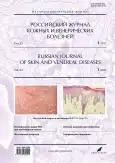Клинико-патогенетическое обоснование применения метотрексата в лечении прогрессирующего несегментарного витилиго
- Авторы: Тавитова А.Р.1, Ломоносов К.М.1
-
Учреждения:
- Первый Московский государственный медицинский университет имени И.М. Сеченова (Сеченовский Университет)
- Выпуск: Том 25, № 1 (2022)
- Страницы: 17-27
- Раздел: ДЕРМАТОЛОГИЯ
- URL: https://journals.rcsi.science/1560-9588/article/view/105122
- DOI: https://doi.org/10.17816/dv105122
- ID: 105122
Цитировать
Аннотация
Обоснование. Витилиго является актуальной проблемой как для пациентов, так и для научного сообщества дерматологов. Проводится множество исследований, направленных на поиск новых методов терапии данного заболевания, однако схем лечения, обеспечивающих репигментацию очагов и стабилизацию процесса, нет. В связи с этим актуален поиск средств, оказывающих патогенетическое действие.
Цель ― клинико-лабораторная оценка эффективности применения метотрексата при витилиго.
Материал и методы. Представлены предварительные результаты исследования эффективности метотрексата при лечении витилиго. Клинические эффекты оценивались с использованием индекса VES (оценка степени витилиго). Определены также динамика иммунологических показателей и влияние витилиго на качество жизни.
В исследование было включено 77 пациентов, страдающих несегментарным витилиго. Все исследуемые были разделены на 2 группы. Пациенты 1-й группы (39 больных) получали метотрексат в сочетании с фототерапией, пациентам 2-й группы (38 больных) проведён курс фототерапии с использованием ультрафиолетовых лучей типа В с длинной волны 311 нм (УФБ-311 нм). Определялась площадь депигментации, а после лечения ― репигментации относительно площади поверхности тела. Анализировалась динамика иммунного статуса на фоне проводимой терапии. Оценивалась корреляция распространённости процесса с качеством жизни. Продолжительность исследования составила 4 мес.
Результаты. Статистически значимых различий до лечения по клиническим и лабораторным показателям среди групп не выявлено. Пациенты 1-й группы (комбинированная терапия метотрексатом в сочетании со средневолновой узкополосной терапией УФБ-311 нм) продемонстрировали не только более активную репигментацию очагов витилиго, чем исследуемые 2-й группы, но и наиболее активную положительную динамику дерматологического индекса качества жизни, коррелирующую с распространённостью процесса. Анализ динамики показателей иммунного статуса позволил сделать вывод о наилучшей тенденции к нормализации уровня цитокинов среди пациентов 1-й группы.
Заключение. Проведённое исследование продемонстрировало клиническую и патогенетическую эффективность метотрексата. Малые дозы препарата хорошо переносятся, что позволяет длительно воздействовать на патогенетические механизмы, стабилизируя кожный процесс.
Ключевые слова
Полный текст
Открыть статью на сайте журналаОб авторах
Алана Руслановна Тавитова
Первый Московский государственный медицинский университет имени И.М. Сеченова (Сеченовский Университет)
Автор, ответственный за переписку.
Email: alatavitova@mail.ru
ORCID iD: 0000-0003-1930-0073
SPIN-код: 2113-9091
аспирант
Россия, МоскваКонстантин Михайлович Ломоносов
Первый Московский государственный медицинский университет имени И.М. Сеченова (Сеченовский Университет)
Email: lamclinic@yandex.ru
ORCID iD: 0000-0002-4580-6193
SPIN-код: 4784-9730
д.м.н., профессор
Россия, МоскваСписок литературы
- Taïeb A., Picardo M. Clinical practice. Vitiligo // N Engl J Med. 2009. Vol. 360, N 2. P. 160–169. doi: 10.1056/NEJMcp0804388
- Олисова О.Ю., Андреева Е.В. Еще раз о проблеме гиперпигментации // Российский журнал кожных и венерических болезней. 2014. Т. 17, № 2. С. 20–24.
- Олисова О.Ю., Владимирова Е.В., Бабушкин А.М. Кожа и солнце // Российский журнал кожных и венерических болезней. 2012. Т. 15, № 6. С. 57–62.
- Krüger C., Schallreuter K.U. A review of the worldwide prevalence of vitiligo in children/adolescents and adults // Int J Dermatol. 2012. Vol. 51, N 10. P. 1206–12120. doi: 10.1111/j.1365-4632.2011.05377.x
- Рахимов У.С., Мухамадиева К.М., Исматуллоева С.С. Нейровегетативные нарушения в патогенезе витилиго // Вестник Авиценны. 2017. Т. 19, № 4. С. 550–555. doi: 10.25005/2074-0581-2017-19-4-550-555
- Hexsel C.L., Eide M.J., Johnson C.C., et al. Incidence of nonmelanoma skin cancer in a cohort of patients with vitiligo // J Am Acad Dermatol. 2009. Vol. 60, N 6. P. 929–933. doi: 10.1016/j.jaad.2008.09.033
- Родионов А.Н., Заславский Д.В., Садыков А.А. Клиническая дерматология. Иллюстрированное руководство для врачей. Москва: ГЭОТАР-Медиа, 2019. 712 с.
- Шарафутдинова Л.А., Ломоносов К.М. К вопросу о классификации витилиго // Российский журнал кожных и венерических болезней. 2014. № 2. С. 37–40.
- Бабешко О.А., Ломоносов К.М., Гилядова Н.И. Роль цитокинов в патогенезе витилиго // Российский журнал кожных и венерических болезней. 2012. № 3. С. 37–41.
- Chan E.S., Cronstein B.N. Methotrexate ― how does it really work? // Nat Rev Rheumatol. 2010. Vol. 6, N 3. С. 175–178. doi: 10.1038/nrrheum.2010.5
- Haskó G., Linden J., Cronstein B., et al. Adenosine receptors: therapeutic aspects for inflammatory and immune diseases // Nat Rev Drug Discov. 2008. Vol. 7, N 9. Р. 759–770. doi: 10.1038/nrd2638
- Cronstein B.N. The mechanism of action of methotrexate // Rheum Dis Clin North Am. 1997. Vol. 23, N 4. P. 739–755. doi: 10.1016/s0889-857x(05)70358-6
- Насонов Е.Л. Метотрексат: перспективы применения в ревматологии. Москва: Филоматис, 2005. 200 с.
- Haskó G., Cronstein B.N. Adenosine: an endogenous regulator of innate immunity // Trends Immunol. 2004. Vol. 25, N 1. P. 33–39. doi: 10.1016/j.it.2003.11.003
- Сускова В.С., Пинсон И.Я., Олисова О.Ю. Иммунопатогенез псориаза // Клиническая дерматология и венерология. 2006. Т. 4, № 1. С. 68–70.
- Олисова О.Ю., Теплюк Н.П., Пинегин В.Б. Современные методы лечения псориаза // РМЖ. 2015. Т. 23, № 9. С. 483–484.
- Cronstein B.N., Naime D., Ostad D. The anti-inflammatory mechanism of methotrexate: increased adenosine release at inflamed sites diminishes leukocyte accumulation in an in vivo model of inflammation // J Clin Invest. 1993. Vol. 92, N 6. P. 2675–2682. doi: 10.1172/JCI116884
- Moser B., Wolf M., Walz A., Loetscher P. Chemokines: multiple levels of leukocyte migration control // Trends Immunol. 2004. Vol. 25, N 2. P. 75–84. doi: 10.1016/j.it.2003.12.005
- Rossi D., Zlotnik A. The biology of chemokines and their receptors // Annu Rev Immunol. 2000. Vol. 18. P. 217–242. doi: 10.1146/annurev.immunol.18.1.217
Дополнительные файлы











